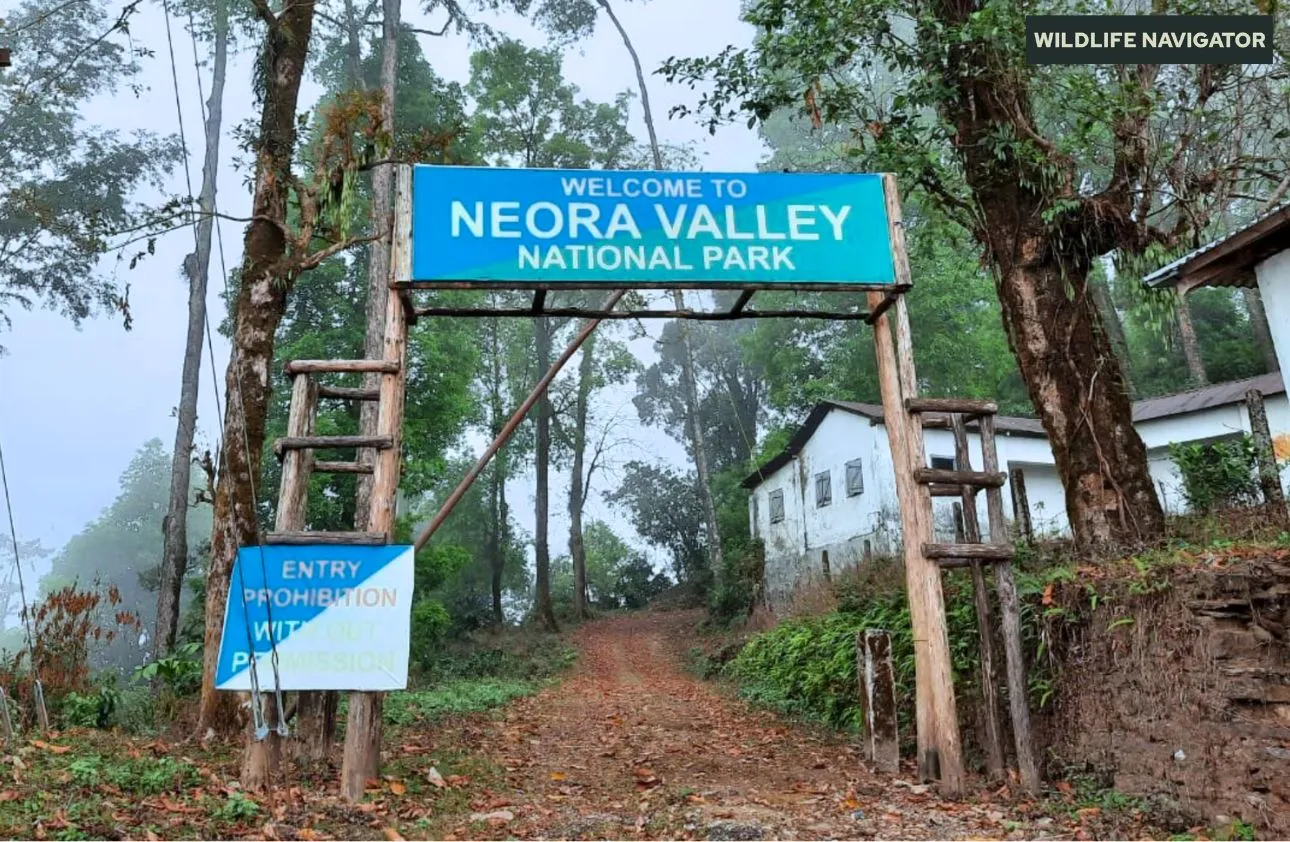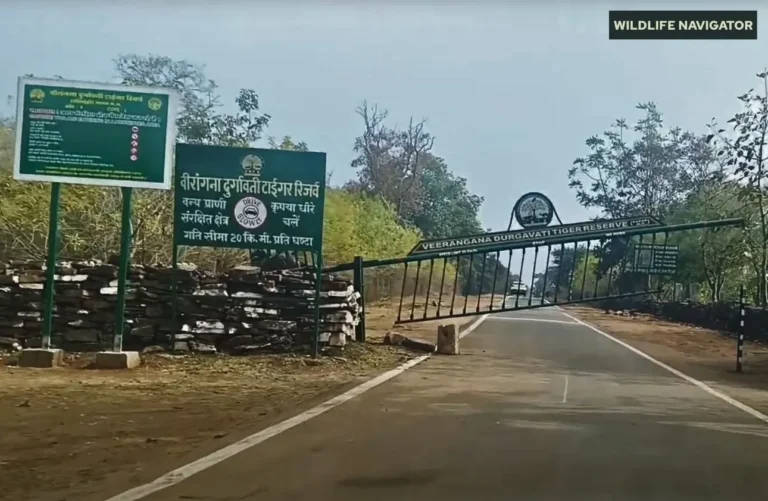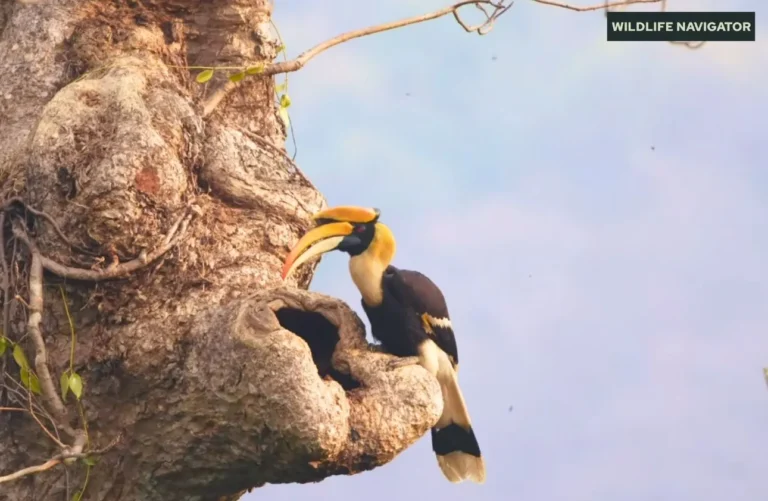Neora Valley National Park – Kalimpong, WestBengal

Neora Valley National Park, located in the Eastern Himalayas of West Bengal, is one of the most pristine forest landscapes among the National Parks in India. This protected wilderness is known for deep green valleys, thick bamboo groves, moss-covered trees, and cold mountain streams flowing through dense Himalayan forests.
It was initially declared a Wildlife Sanctuary in 1961 under the West Bengal Forest Department, and later upgraded to a National Park in 1986 (with its final notification issued in 1992), primarily to provide stronger protection to its exceptional biodiversity and endangered species.
Today, the park shelters rare and iconic fauna such as the Red Panda, Clouded Leopard, and an extraordinary diversity of birds, orchids, and high-altitude plant life.
The untouched atmosphere, mist-filled trails, and dramatic elevation range make Neora Valley a true stronghold of biodiversity—an ideal destination for travellers seeking raw Himalayan nature, serene trekking routes, and rich wildlife experiences.
Location, Geography, and Significance
Geographic Setting
Neora Valley National Park is located in the Kalimpong district of West Bengal, nestled in the Eastern Himalayas. The park lies close to the borders of Sikkim and Bhutan, forming part of a crucial transboundary ecological landscape. Covering a wide altitudinal range—from roughly 183 meters to over 3,200 meters—the terrain includes deep valleys, dense forests, and high mountain ridges.
The park surrounds the watershed of the Neora River and features lush subtropical forests, temperate broadleaf woodlands, and alpine vegetation zones, creating diverse habitats across elevations. Mist-laden hills, moss-covered trees, and remote wilderness contribute to its mystical, untouched appeal.
Ecological Importance
Neora Valley represents one of the last surviving tracts of pristine temperate forest in India. The park plays a vital role in the Eastern Himalayan Biodiversity Hotspot, which is globally celebrated for its species richness and endemism.
The rugged landscape forms a natural wildlife corridor linking forest ecosystems of West Bengal, Sikkim, and Bhutan, allowing free movement of rare and threatened species such as the Red Panda and clouded leopard.
Established in 1986 for conservation, the park remains largely unexplored due to its remote terrain, aiding in natural ecosystem preservation.
Global Recognition
Neora Valley’s untouched wilderness and exceptional biodiversity have earned it notable international attention. The park was added to the UNESCO World Heritage Tentative List on 26 May 2009, as part of the Eastern Himalayan natural heritage cluster.
This means Neora Valley is officially recognised by UNESCO as a potential World Heritage Site, but as of 2025, it has not yet been granted full World Heritage status. Being placed on the Tentative List is the first formal step toward eventual inscription.
The UNESCO acknowledgement highlights Neora Valley’s ecological significance, its role in climate resilience, and its importance in conserving Himalayan flora and fauna. It is viewed as a critical conservation landscape for safeguarding fragile mountain ecosystems and promoting sustainable, low-impact nature tourism.
Flora
Neora Valley’s vegetation spans multiple forest types due to its broad elevation range, creating a rich plant community that thrives in moist Himalayan conditions. Dense evergreen forests dominate lower altitudes, giving way to mixed coniferous woods and rhododendron groves at higher slopes. The park is home to an impressive diversity of flowering plants, mosses, ferns, and bamboo, many of which thrive in its cool, misty climate and unspoiled soil.
Major vegetation types
- Subtropical broadleaf forests
- Temperate broadleaf and conifer forests
- Rhododendron forests
- Bamboo groves
- High-altitude alpine scrub
Notable plant species
- Rhododendrons (multiple species)
- Oak and hemlock
- Magnolia
- Bamboo and cane species
- Medicinal herbs and aromatic plants
- Rare orchids and ferns
Fauna of Neora Valley National Park
The park is renowned for its rich wildlife, notably serving as a stronghold for the Red Panda—one of the most charismatic and endangered Himalayan mammals. Its thick forest canopy and secluded valleys shelter elusive predators, herbivores, and small mammals.
Neora Valley is equally famous among birdwatchers, hosting numerous rare Himalayan and migratory species. Amphibians, insects, and butterflies add further ecological diversity.
Key mammals
- Red Panda
- Clouded Leopard
- Himalayan Black Bear
- Goral
- Leopard Cat
- Civets and martens
Birdlife highlights
- Satyr Tragopan
- Rufous-necked Hornbill
- Golden-headed Cisticola
- Black-eared Shrike Babbler
- Scarlet Finch
- Various laughingthrushes and warblers
Other wildlife
- Himalayan lizards and geckos
- Tree frogs and salamanders
- Diverse butterfly species, including Kaiser-i-Hind
Best Time to Visit
Neora Valley National Park remains accessible during select months of the year due to weather and conservation restrictions. The best time to explore the region is when visibility is clear, trails are safe, and wildlife activity is high.
Ideal Visiting Period
October to April is considered the prime season, offering pleasant weather and excellent opportunities for trekking, birdwatching, and wildlife sighting.
Seasonal Overview
- October – November:
Crisp air, post-monsoon clarity, lush green landscapes, excellent for photography and birding. - December – February:
Cold winter months with chances of snowfall at higher altitudes; great for spotting Himalayan species; warm clothing essential. - March – April:
Rhododendrons and wildflowers bloom; vibrant forests; ideal for trekking and nature viewing.
Avoidable Period
- May – September:
The park remains mostly closed during the monsoon due to heavy rainfall, landslides, leeches, and slippery trails. Limited access is maintained for safety and habitat protection.
Things to Do
Neora Valley National Park offers nature-focused activities that emphasize wilderness immersion, wildlife observation, and peaceful Himalayan landscapes. The experience prioritizes eco-tourism and low-impact exploration.
Birdwatching
Neora Valley is one of India’s top birding destinations, particularly for Himalayan and migratory species. Key hotspots include:
- Lava
- Kolakham
- Rishop
- Around Rechela Pass
Birders often spot hornbills, laughingthrushes, warblers, and rare Himalayan pheasants.
Wildlife Spotting
Though sightings can be challenging due to thick vegetation, patient visitors may observe:
- Red Panda resting in tree canopies
- Barking deer and goral on slopes
- Martens, civets, and Himalayan squirrels
Night safaris are not permitted; all viewing is via guided forest entry.
Photography
The park’s dramatic landscapes, misty forests, and diverse creatures make it ideal for:
- Landscape photography
- Bird portrait sessions
- Macro photography of insects and orchids
- Seasonal foliage and winter mist shots
Village and Eco-Tourism Experiences
Local villages like Kolakham and Rishop provide opportunities to engage with mountain hospitality and witness traditional Himalayan lifestyles. Eco-lodges and homestays are common, supporting community-based tourism.
Major Trekking Routes
Neora Valley National Park is known for its raw Himalayan terrain, offering trekking routes that traverse dense forests, high ridges, and remote wilderness zones. Most trails require forest guides and permits due to protected status and challenging conditions.
Key Trekking Trails
Lava to Kolakham Trail
- Easy to moderate route
- Passes through dense forest belts and birding hotspots
- Popular among nature walkers and photographers
Lava to Rishop/Rishyap Trail
- Short scenic hike with panoramic Himalayan views
- Dense vegetation, mossy pathways, and village scenery
- Suitable for beginners
Kolakham to Neora Valley Core Zone Entry
- Requires guide and permission
- Known for Red Panda habitat and bamboo wilderness
- Excellent for wildlife enthusiasts and serious trekkers
Rechela Pass (Rechela Danda) Route
- Highest point of the park, near Bhutan–Sikkim border
- Best for experienced trekkers
- Rich rhododendron belts, high-elevation birds, and alpine scenery
Samsing – Suntalekhola – Neora Range Trail
- Forest trail filled with streams and waterfalls
- Excellent birding corridor
- Connects scenic valleys and village landscapes
How to Reach
Neora Valley National Park is well-connected through Kalimpong and Siliguri, though the final stretches involve hilly roads and forest routes. Transport options include road travel from major towns, with access limited inside the park to trekking and designated entry gates.
Nearest Transport Hubs
- Nearest Airport: Bagdogra Airport (approx. 100–120 km depending on entry point)
- Nearest Major Railway Station: New Jalpaiguri (NJP) (approx. 100–115 km)
- Nearest Towns: Kalimpong, Lava, Rishop, Kolakham, Samsing
Road Connectivity
Regular transport options are available from:
- Siliguri
- Kalimpong
- Darjeeling
- Gangtok (towards Lava/Rishop side)
Shared jeeps, taxis, and private cars connect these towns to park gateways. Roads can be steep and narrow, especially near Lava and Kolakham.
Route Highlights
Popular approach routes:
- Siliguri → Kalimpong → Lava
- Siliguri → Malbazar → Samsing → Suntalekhola
- Gangtok/Darjeeling → Kalimpong → Lava
Entry Fee, Points and Permits
Access to Neora Valley National Park is carefully regulated to protect its fragile Himalayan ecosystems and ensure visitor safety. Only designated entry gates and trekking routes are open to the public, and permits are mandatory for entering core forest zones.
Permit Fees and Associated Costs
- Entry Permit
- ₹130 per Indian national
- ₹500 per foreign national
- Vehicle Entry
- Four-wheeler: ₹400–₹600
- Two-wheeler: ₹120
- Guide Fee (Mandatory in core zones)
- ₹350–₹500 per day, depending on route and distance
- Optional Services
- Jeep Safari: approx. ₹1500 per full jeep
- Camping: ₹100 per person per day
Permit Requirements
All visitors entering trekking routes or sensitive habitats must obtain an official forest permit. Permits generally include:
- Entry pass
- Camera fee (where applicable)
- Mandatory guide assignment for protected trails
Where to Get Permits:
- Forest Office, Lava (main issuing point)
- Range Office, Suntalekhola / Samsing route
Main Entry Points
Lava Gate (Primary Entry)
- Most popular access point for visitors
- Forest Department office available for on-spot permits
- Gateway to major trekking trails and birdwatching routes
Kolakham Entry Zone
- Entryway to dense bamboo forests and key Red Panda habitats
- Guide and forest permission required
- Favoured by wildlife photographers and serious nature enthusiasts
Samsing – Suntalekhola Route
- Southern access point with scenic river valleys, waterfalls, and excellent birding spots
- Much quieter and less crowded compared to Lava
Regulations and Visitor Guidelines
- No entry into core areas without an official guide
- Drone photography is strictly prohibited
- Littering, loud noise, or wildlife disturbance is not allowed
- Offences are punishable under forest laws
- Early morning entry and advance planning are recommended to improve sighting chances and ensure trail availability
- Start early to avoid mountain fog and road congestion
- 4×4 vehicle recommended in winter or during rains
- Limited public transport late evening; pre-book taxis where possible
Accommodation
Accommodation around Neora Valley National Park focuses on eco-friendly lodging, forest rest houses, and homestays that provide an immersive Himalayan experience. Options range from basic forest huts to comfortable mountain cottages with scenic valley and forest views.
Forest Lodges & Government Stays
Forest accommodations are limited and require advance booking, especially during peak season. These offer rustic stays close to nature.
Common locations:
- Lava Forest Lodge
- Kolakham Forest Rest House
- Suntalekhola Nature Camp
Features:
- Basic rooms with essential amenities
- Peaceful surroundings, forest-edge views
- Ideal for birders and wildlife enthusiasts
Eco-Resorts & Homestays
Villages surrounding the park offer eco-stays with warm hospitality and local cuisine.
Popular stay hubs:
- Kolakham (closest wildlife access, bamboo zone)
- Rishop/Rishyap (Himalayan peak views)
- Lava town (easy accessibility, budget stays)
- Suntalekhola (riverside forest retreat)
Typical amenities:
- Mountain-view rooms
- Local homemade food
- Guided trekking and birdwatching support
Booking Tips
- Reserve well in advance (especially October–April)
- Confirm electricity, hot water, and transport options
- Choose stays near entry gates for early forest entry
- Opt for homestays to support local communities
Conservation Initiatives
Neora Valley National Park is a major Himalayan conservation zone, dedicated to protecting rare mountain ecosystems, endangered species, and fragile habitats. Its remote landscape and strict forest regulations support long-term biodiversity preservation.
Conservation Focus Areas
- Protection of temperate Himalayan forests and alpine ecosystems
- Habitat preservation for endangered species such as the Red Panda
- Maintenance of wildlife corridors linking West Bengal, Sikkim, and Bhutan
- Control of illegal logging, poaching, and habitat disturbance
Key Projects & Efforts
- Red Panda Conservation Programs:
Research and monitoring of wild populations, habitat study, and community awareness drives. - Biodiversity Monitoring:
Camera traps, bird surveys, and ecological studies to track species richness and threats. - Eco-Tourism Initiatives:
Promotion of sustainable tourism through regulated entry, trained guides, and eco-stays. - Community Participation:
Local villages such as Kolakham and Rishop are engaged in conservation through homestays, eco-tourism jobs, and forest protection awareness.
Challenges
- Difficult terrain limits patrol coverage
- Seasonal tourism pressure in vulnerable habitats
- Climate change is affecting mountain species and flowering cycles
- Road and infrastructure development risks near buffer zones
Visitor Contribution
- Choose eco-friendly stays and local guides
- Avoid littering and minimise plastic use
- Support community-based tourism
- Respect wildlife and avoid disturbance
Nearby Attractions
Neora Valley sits amid a scenic and culturally rich Himalayan belt, offering several nearby destinations that complement a wilderness-focused trip. Visitors can combine their park visit with hill villages, monasteries, and other wildlife zones.
Key Nearby Places
- Lava Monastery (Kagyu Thekchen Ling Monastery)
- Prominent Buddhist monastery near Lava
- Peaceful setting with prayer flags and mountain views
- Loleygaon (Lolegaon) Canopy Walk
- Forest village is known for its hanging canopy bridge
- Ideal for birdwatching and sunrise views of Kanchenjunga
- Kolakham Village
- Forest-edge settlement with panoramic Himalayan views
- Popular for birding and Red Panda habitat proximity
- Rishop (Rishyap)
- Hilltop village with wide-angle views of the Kanchenjunga range
- Quiet retreat with homestays and nature trails
- Suntalekhola & Rocky Island
- Riverside picnic and birdwatching spots near Samsing
- Scenic walking trails, waterfalls, and hanging bridges
- Gorumara & Jaldapara National Parks
- Wildlife reserves nearby (2–4 hours by road)
- Known for elephants, rhinos, and grassland species
Suggested Trip Combinations
- Neora Valley + Kalimpong sightseeing
- Lava–Rishop–Kolakham nature circuit
- Neora Valley + Gorumara/Jaldapara for a wildlife tour circuit
Conclusion
Neora Valley National Park stands as one of India’s most untouched Himalayan wilderness zones, protecting rare forests, endangered species like the Red Panda, and vital ecological corridors. Its misty landscapes, dense bamboo groves, and rich birdlife offer a raw, immersive nature experience for trekkers and wildlife lovers. Responsible travel, guided entry, and support for local communities help preserve this fragile ecosystem for future generations.





